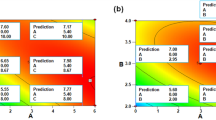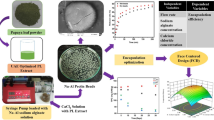Abstract
Lycopene extracted from pink grapefruit was encapsulated on Ca(II)-alginate beads with the addition of trehalose and galactomannans to improve its stability against freezing and drying. Three galactomannans of different physicochemical properties were studied since their inclusion affects both loading efficiency and release of lycopene in wet beads; however, there is no information about their performance during freezing and dehydration operations. The remaining lycopene and its stability towards isomerization were analyzed in beads subjected to continuous freezing, freezing/thawing cycles and vacuum- and freeze-drying. Isothermal crystallization studies were conducted by LF-NMR and related to beads formulation and lycopene stability. In the absence of excipients, lycopene was severely affected by all the treatments, retaining less than 20% of the original content. Alginate beads containing trehalose with guar gum protected more than 80% of the lycopene regardless of the employed freezing or drying methods. These beads concomitantly showed higher solid fraction than the other two galactomannans-containing systems, displaying guar gum ability to associate water. On the other hand, the addition of vinal gum affected lycopene stability (between 40 and 60% were recovered after treatments), even compromising the positive effect of a well-established cryoprotectant as trehalose. Thus, the addition of secondary excipients should be carefully conducted. The differences among galactomannans could be related to the substitution degree of the polymer chains, affecting the overall systems interactions. These results can contribute to excipients selection for the encapsulation of labile biomolecules in Ca(II)-alginate beads subjected to freezing and drying.





Similar content being viewed by others
References
Aguirre Calvo TR, Santagapita PR (2016) Physicochemical characterization of alginate beads containing sugars and biopolymers. J Qual Reliab Eng. https://doi.org/10.1155/2016/9184039
Aguirre Calvo TR, Santagapita PR (2017) Encapsulation of a free-solvent extract of lycopene in alginate-Ca(II) beads containing sugars and biopolymers. Chem Biol Technol Agric 4:16. https://doi.org/10.1186/s40538-017-0099-3
Aguirre Calvo TR, Santagapita PR (2019) Pink grapefruit’ lycopene encapsulated in alginate-based beads: stability towards freezing and drying. Int J Food Sci Technol 54:368–375. https://doi.org/10.1111/ijfs.13946
Aguirre Calvo TR, Busch VM, Santagapita PR (2017) Stability and release of an encapsulated solvent-free lycopene extract in alginate-based beads. LWT Food Sci Technol 77:406–412. https://doi.org/10.1016/j.lwt.2016.11.074
Álvarez Cerimedo MS, Iriarte CH, Candal RJ, Herrera ML (2010) Stability of emulsions formulated with high concentrations of sodium caseinate and trehalose. Food Res Int 43:1482–1493. https://doi.org/10.1016/j.foodres.2010.04.008
Barankevicz GB, Novello D, Resende JT, Schwarz K, Santos EF (2015) Physical and chemical characteristics of tomato hybrids pulp during frozen storage. Hortic Bras 33:7–11. https://doi.org/10.1590/S0102-053620150000100002
Busch VM, Pereyra-Gonzalez A, Segatin N, Santagapita PR, Poklar Ulrih N, Buera MP (2017) Propolis encapsulation by spray drying: characterization and stability. LWT Food Sci Technol 75:227–235. https://doi.org/10.1016/j.lwt.2016.08.055
Busch VM, Delgado JF, Santagapita PR, Wagner JR, Buera MP (2018) Rheological characterization of vinal gum, a galactomannan extracted from Prosopis ruscifolia seeds. Food Hydrocoll 74:333–341. https://doi.org/10.1016/j.foodhyd.2017.08.010
Costa-Rodrigues J, Pinho O, Monteiro PRR (2018) Can lycopene be considered an effective protection against cardiovascular disease? Food Chem 245:1148–1153. https://doi.org/10.1016/j.foodchem.2017.11.055
Dias MG, Camões MFG, Oliveira L (2014) Carotenoid stability in fruits, vegetables and working standards—effect of storage temperature and time. Food Chem 156:37–41. https://doi.org/10.1016/j.foodchem.2014.01.050
Hammer A (2008) The characterization of olive oils by DSC. Therm Anal UserCom 28:6–8
Perduca MJ, Spotti MJ, Santiago LG, Judis MA, Rubiolo AC, Carrara CR (2013) Rheological characterization of the hydrocolloid from Gleditsia amorphoides seeds. LWT Food Sci Technol 51:143–147. https://doi.org/10.1016/j.lwt.2012.09.007
Pérez-Masiá R, Lagaron JM, Lopez-Rubio A (2015) Morphology and stability of edible lycopene-containing micro-and nanocapsules produced through electrospraying and spray drying. Food Bioprocess Technol 8:459–470. https://doi.org/10.1007/s11947-014-1422-7
Pushpamalar J, Veeramachineni AK, Owh C, Loh XJ (2016) Biodegradable polysaccharides for controlled drug delivery. ChemPlusChem 81:504–514. https://doi.org/10.1002/cplu.201600112
Quintanilla-Carvajal MX, Camacho-Díaz BH, Meraz-Torres LS, Chanona-Peréz JJ, Alamilla-Beltrán L, Jimenéz-Aparicio A, Gutiérrez-López GF (2010) Nanoencapsulation: a new trend in food engineering processing. Food Eng Rev 2:39–50. https://doi.org/10.1007/s12393-009-9012-6
Rodríguez Amaya DB, Kimura M (2016) Harvestplus handbook for carotenoid analysis. In: HarvestPlus
Shi J (2000) Lycopene in tomatoes: chemical and physical properties affected by food processing. Crit Rev Biotechnol 20:293–334. https://doi.org/10.1080/07388550091144212
Sinha N, Dua D (2015) Lycopene: most potent antioxidant with endless benefits. Int J Pharma Bio Sci 6:838–846
Souza AL, Hidalgo-Chávez DW, Pontes SM, Gomes FS, Cabral LM, Tonon RV (2018) Microencapsulation by spray drying of a lycopene-rich tomato concentrate: characterization and stability. LWT Food Sci Technol 91:286–292. https://doi.org/10.1016/j.lwt.2018.01.053
Stahl W, Sies H (1996) Lycopene: A biologically important carotenoid for humans? Arch Biochem Biophys 336:1–9. https://doi.org/10.1006/abbi.1996.0525
Torres MD, Hallmark B, Wilson DI (2014) Effect of concentration on shear and extensional rheology of guar gum solutions. Food Hydrocoll 40:85–95. https://doi.org/10.1016/j.foodhyd.2014.02.011
Traffano-Schiffo MV, Aguirre Calvo TR, Castro-Giraldez M, Fito PJ, Santagapita PR (2017a) Alginate beads containing lactase: stability and microstructure. Biomacromol 18:1785–1792. https://doi.org/10.1021/acs.biomac.7b00202
Traffano-Schiffo MV, Castro-Giraldez M, Fito PJ, Santagapita PR (2017b) Encapsulation of lactase in Ca(II)-alginate beads: effect of stabilizers and drying methods. Food Res Int 100:296–303. https://doi.org/10.1016/j.foodres.2017.07.020
Traffano-Schiffo MV, Castro-Giraldez M, Fito PJ, Perullini M, Santagapita PR (2018) Gums induced microstructure stability in Ca(II)-alginate beads containing lactase analyzed by SAXS. Carbohydr Polym 179:402–407. https://doi.org/10.1016/j.carbpol.2017.09.096
Urbonaviciene D, Viskelis P (2017) The cis-lycopene isomers composition in supercritical CO2 extracted tomato by-products. LWT Food Sci Technol 85:517–523. https://doi.org/10.1016/j.lwt.2017.03.034
Vitale AA, Bernatene EA, Pomilio AB (2010) Carotenoides en quimioprevención: Licopeno. Acta Bioquím Clín Latinoam 44:195–238
Acknowledgements
The authors acknowledge the financial support of ANPCYT (PICT 2017-0569), CIN-CONICET (PDTS 2015 n° 196) and UBA (Project UBACyT 20020130100610BA). We also acknowledge Dr. Verónica Busch for vinal gum donation. TRAC acknowledge CONICET for the Ph.D. scholarship. PRS is member of CONICET.
Author information
Authors and Affiliations
Corresponding author
Ethics declarations
Conflict of interest
The author declares that there is no conflict of interests regarding the publication of this paper.
Additional information
Publisher's Note
Springer Nature remains neutral with regard to jurisdictional claims in published maps and institutional affiliations.
Electronic supplementary material
Below is the link to the electronic supplementary material.
Rights and permissions
About this article
Cite this article
Aguirre Calvo, T.R., Santagapita, P.R. Freezing and drying of pink grapefruit-lycopene encapsulated in Ca(II)-alginate beads containing galactomannans. J Food Sci Technol 56, 3264–3271 (2019). https://doi.org/10.1007/s13197-019-03783-w
Revised:
Accepted:
Published:
Issue Date:
DOI: https://doi.org/10.1007/s13197-019-03783-w




